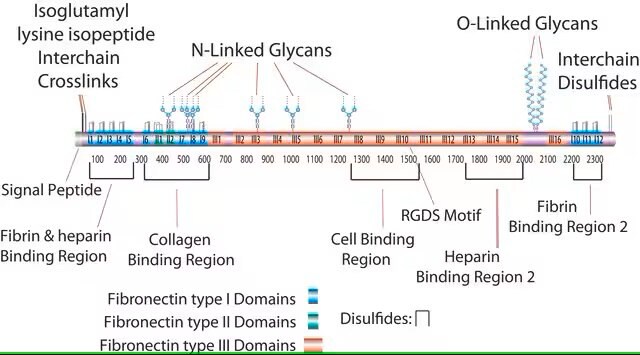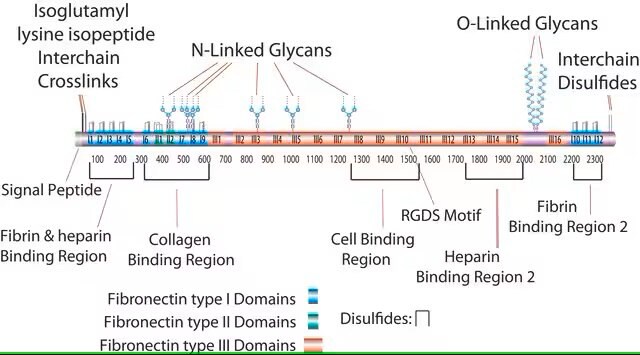We test the coated culture surface by culturing cells. We compare the adherence of the cells to wells that have been coated with media containing BSA (negative) and media containing 10% FBS (positive). The cell growth should be not less than 50% of the positive control and greater than 50% of the negative control.
Wichtige Dokumente
F2006
Human Fibronectin
from human plasma, powder, suitable for cell culture
Synonym(e):
Fibronectin
Größe auswählen
Größe auswählen
About This Item
Empfohlene Produkte
Produktbezeichnung
Fibronectin-Humanplasma, lyophilized powder, BioReagent, suitable for cell culture
Biologische Quelle
human plasma
Qualitätsniveau
Sterilität
sterile
Produktlinie
BioReagent
Assay
≥85% (SDS-PAGE)
Form
lyophilized powder
Mol-Gew.
450 kDa
Verpackung
pkg of 5 x 5 mg
pkg of 1 mg
pkg of 2 mg
pkg of 5 mg
Konzentration
>1 mg/mL protein
Methode(n)
cell culture | mammalian: suitable
Oberflächendeckung
1‑5 μg/cm2
Verunreinigungen
HBSAG, none detected
HCV, none detected
HIV-1/HIV-2, none detected
Löslichkeit
H2O: 1 mg/mL at 37 °C (Store reconstituted solution in working aliquots at -20°C or lower.)
NCBI-Hinterlegungsnummer
UniProt-Hinterlegungsnummer
Bindungsspezifität
Peptide Source: Collagen
Versandbedingung
dry ice
Lagertemp.
−20°C
Angaben zum Gen
human ... FN1(2335)
Suchen Sie nach ähnlichen Produkten? Aufrufen Leitfaden zum Produktvergleich
Allgemeine Beschreibung
Anwendung
- Zellaussaat und neuronale Differenzierung (als eine der Komponenten in Expansionsmedium für die Resuspendierung von Nabelschnurblut-Stammzellen (CBSC) sowie in Differenzierungsmedium)[3]
- Zellkultur (die Kulturkammer wird zur Expression von HEK293-Zellen mit Fibronektin beschichtet)[4]
- In-vitro-Fibronektin(FN)-Pulldown-Assays[5]
- Proteinspezifität[6]
- Zellmigrationsstudien[7]
Biochem./physiol. Wirkung
Vorsicht
Angaben zur Herstellung
Haftungsausschluss
Lagerklassenschlüssel
11 - Combustible Solids
WGK
WGK 3
Flammpunkt (°F)
Not applicable
Flammpunkt (°C)
Not applicable
Persönliche Schutzausrüstung
Eyeshields, Gloves, type N95 (US)
Hier finden Sie alle aktuellen Versionen:
Analysenzertifikate (COA)
Die passende Version wird nicht angezeigt?
Wenn Sie eine bestimmte Version benötigen, können Sie anhand der Lot- oder Chargennummer nach einem spezifischen Zertifikat suchen.
Besitzen Sie dieses Produkt bereits?
In der Dokumentenbibliothek finden Sie die Dokumentation zu den Produkten, die Sie kürzlich erworben haben.
Kunden haben sich ebenfalls angesehen
Artikel
Fibronectin (FN) plays crucial roles in extracellular matrix fibril assembly and cellular interactions.
The extracellular matrix (ECM) and its attachment factor components are discussed in this article in relation to their function in structural biology and their availability for in vitro applications.
The extracellular matrix (ECM) is secreted by cells and surrounds them in tissues.
3D cell culture overview. Learn about 2D vs 3D cell culture, advantages of 3D cell culture, and techniques available to develop 3D cell models
Protokolle
Fibronectin auf die gewünschte Konzentration verdünnen. Die optimalen Anhaftungsbedingungen sind vom Zelltyp und der Anwendung abhängig. Die typische Beschichtungskonzentration beträgt 1–5 ug/cm2. Protokoll, Produkte und häufig gestellte Fragen zur Fibronectin-Beschichtung.
Dilute fibronectin for cell attachment, varying per cell type. Coating protocol, products, and FAQs provided.
Verwandter Inhalt
Defined culture conditions. Consistent growth of human cancer cell lines in PromoCell’s serum-free/xeno-free Cancer Cell Line Media-XF. Explore over 350 PromoCell products on Sigma.com
-
How do I test the wells/flasks that have been coated with fibronectin?
1 Antwort-
Hilfreich?
-
-
How do I determine how much fibronectin is in solution?
1 Antwort-
As the product may contain undissolved material, the amount of fibronectin in solution can be determined by UV absorbance. The extinction coefficient for a 1% solution (10 mg/ml) is 13.5 at 280 nm.
Hilfreich?
-
-
What is the procedure for coating culture surfaces with fibronectin?
1 Antwort-
To coat culture surfaces: 1. Dilute fibronectin in sterile balanced salt solution and coat the culture surface (1-5 μg/cm2) with a minimal volume. 2. Allow to air dry for at least 45 minutes at room temperature. Excess fibronectin may be removed by aspiration, but this is not necessary.
Hilfreich?
-
-
How do I solubilized Fibronectin?
1 Antwort-
Dissolve at 1 mg/mL in water. Allow to dissolve for at least 30 minutes at 37 °C. A small amount of undissolved material may remain. This will not affect product performance.
Hilfreich?
-
-
How do I choose which fibronectin product to use to coat culture surfaces for cell growth?
1 Antwort-
The species source for the fibronectin used when coating culture surfaces is not important. It is the presence of the RGD binding site that is present in all fibronectins that promotes binding.
Hilfreich?
-
-
How long can I store fibronectin coated plates, etc?
1 Antwort-
Fibronectin coated cultureware can be stored for 2-4 weeks at 2-8 °C in a closed sterile container, or in sterile sealable bags.
Hilfreich?
-
-
What is the difference between Fibronection Products F2006 and F1056?
1 Antwort-
The difference between Product Nos. F2006 and F1056 is in the purity specifications and endotoxin testing. Product No. F2006 has a purity specification of ≥90% and is not tested for endotoxin contamination. Product No. F1056 has a purity specification of ≥95% and is tested for endotoxin contamination with a specification of ≤100 EU/mg.
Hilfreich?
-
-
How long can I store the fibronectin solution?
1 Antwort-
The product is good for at least a year at 2-8 °C if kept sterile.
Hilfreich?
-
-
What is the Department of Transportation shipping information for this product?
1 Antwort-
Transportation information can be found in Section 14 of the product's (M)SDS.To access the shipping information for this material, use the link on the product detail page for the product.
Hilfreich?
-
Aktive Filter
Unser Team von Wissenschaftlern verfügt über Erfahrung in allen Forschungsbereichen einschließlich Life Science, Materialwissenschaften, chemischer Synthese, Chromatographie, Analytik und vielen mehr..
Setzen Sie sich mit dem technischen Dienst in Verbindung.







